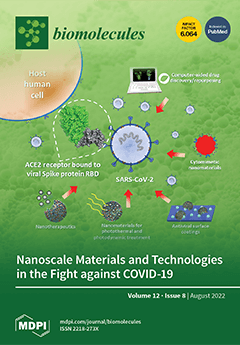The Gram-positive and spore-forming bacterium
Brevibacillus laterosporus (
Bl) belongs to the
Brevibacillus brevis phylogenetic cluster. Isolates of the species have demonstrated pesticidal potency against a wide range of invertebrate pests and plant diseases. Two New Zealand isolates,
Bl 1821L and
Bl 1951, are under development as biopesticides for control of diamondback moth and other pests. However, due to the often-restricted growth of these endemic isolates, production can be an issue. Based on the previous work, it was hypothesised that the putative phages might be involved. During investigations of the cause of the disrupted growth, electron micrographs of crude lysate of
Bl 1821L showed the presence of phages’ tail-like structures. A soft agar overlay method with PEG 8000 precipitation was used to differentiate between the antagonistic activity of the putative phage and phage tail-like structures (bacteriocins). Assay tests authenticated the absence of putative phage activity. Using the same method, broad-spectrum antibacterial activity of
Bl 1821L lysate against several Gram-positive bacteria was found. SDS-PAGE of sucrose density gradient purified and 10 kD MWCO concentrated lysate showed a prominent protein band of ~48 kD, and transmission electron microscopy revealed the presence of polysheath-like structures. N-terminal sequencing of the ~48 kD protein mapped to a gene with weak predicted amino acid homology to a
Bacillus PBSX phage-like element
xkdK, the translated product of which shared >90% amino acid similarity to the phage tail-sheath protein of another
Bl published genome, LMG15441. Bioinformatic analysis also identified an
xkdK homolog in the
Bl 1951 genome. However, genome comparison of the region around the
xkdK gene between
Bl 1821L and
Bl 1951 found differences including two glycine rich protein encoding genes which contain imperfect repeats (1700 bp) in
Bl 1951, while a putative phage region resides in the analogous
Bl 1821L region. Although comparative analysis of the genomic organisation of
Bl 1821L and
Bl 1951 PBSX-like region with the defective phages PBSX, PBSZ, and PBP 180 of
Bacillus subtilis isolates 168 and W23, and
Bacillus phage PBP180 revealed low amino acids similarity, the genes encode similar functional proteins in similar arrangements, including phage tail-sheath (XkdK), tail (XkdO), holin (XhlB), and N-acetylmuramoyl-
l-alanine (XlyA). AMPA analysis identified a bactericidal stretch of 13 amino acids in the ~48 kD sequenced protein of
Bl 1821L. Antagonistic activity of the purified ~48 kD phage tail-like protein in the assays differed remarkably from the crude lysate by causing a decrease of 34.2% in the number of viable cells of
Bl 1951, 18 h after treatment as compared to the control. Overall, the identified inducible phage tail-like particle is likely to have implications for the in vitro growth of the insect pathogenic isolate
Bl 1821L.
Full article






